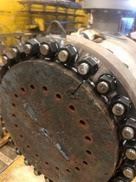
Reduce bolting job time with a Hydraulic torque wrench Introduction T he world is full of tools that we use for various applications. When it comes to the tightening and loosening of bolts and nuts, a torque wrench is the most preferred tool. The tool can be used in almost every bolting application and still deliver accurate and consistent torque output. However, when we talk about major industries like oil & gas, power, wind, steel, cement, and mining industry that can complete bolting jobs faster and deliver lower downtime. To meet such industry requirements, the hydraulic torque wrenches delivers the best power to weight ratio. 1. Knowin g The basics Let us recap what is Torque and a wrench to understand torque wrenches better. Torque Torque is the measurement of force applied on an object which causes it to rotate. Wrench Wrench is a tool used to provide torque to turn objects. The most common shapes are open-end wrench and box-end...


